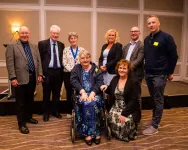(Press-News.org) (Santa Barbara, Calif.) — Gene editing is a powerful method for both research and therapy. Since the advent of the Nobel Prize-winning CRISPR/Cas9 technology, a quick and accurate tool for genome editing discovered in 2012, scientists have been working to explore its capabilities and boost its performance.
Researchers in UC Santa Barbara biologist Chris Richardson’s lab have added to that growing toolbox, with a method that increases the efficiency of CRISPR/Cas9 editing without the use of viral material to deliver the genetic template used to edit the target genetic sequence. According to their new paper published in the journal Nature Biotechnology, their method stimulates homology-directed repair (a step in the gene editing process) by approximately threefold “without increasing mutation frequencies or altering end-joining repair outcomes.”
“We’ve found a chemical modification that improves non-viral gene editing and also discovered an intriguing new type of DNA repair,” Richardson said.
Find, Cut and Paste
The CRISPR/Cas9 method works by capitalizing on a defense technique employed by bacteria against viral attackers. To do this, the bacteria snip a piece of the invading virus’s genetic material, and incorporate it into their own in order to recognize it later. Should the bacteria get reinfected, they can target the now-familiar genetic sequences for destruction.
In gene editing, this process uses the enzyme Cas9 as molecular “scissors” to snip sequences it recognizes, guided by the CRISPR system. This cut is also an opportunity to replace the severed genes with similar (homologous) but improved ones, utilizing the cell’s natural repair mechanisms. If successful, the cell should have modified expressions and functions thereafter.
To deliver the repair template DNA to the nucleus of the cell where its genetic material lives, oftentimes viruses are used. While they are effective, the researchers say, viral workflows “are expensive, difficult to scale and potentially toxic to cells.”
Nonviral templates are potentially less expensive and more scalable, although researchers still must overcome efficiency and toxicity barriers. In their study, the Richardson Lab found that introducing interstrand crosslinks into the workflow increased homology directed repair dramatically.
“Every workflow that we have put this approach into has worked better by roughly threefold,” Richardson said.
Interstrand crosslinks are lesions that keep the double strands of a DNA helix tethered to each other, making them unable to replicate. Cancer chemotherapies use this mechanism to interrupt tumor growth and kill cancer cells. Added to a homology directed repair template, however, these crosslinks were found to stimulate the cell’s natural repair mechanisms and increase the likelihood of editing success.
“Basically, what we’ve done is taken this template DNA and damaged it,” Richardson said. “We’ve in fact damaged it in the most severe way I can think of. And the cell doesn’t say, ‘Hey this is junk; let me throw it away.’ What the cell actually says is, ‘Hey this looks great; let me stick it into my genome.’” The result is a highly efficient and minimally error-prone nonviral system of gene editing.
Their discovery, like many breakthroughs in science, was actually something of a happy accident. While working to purify proteins to study DNA repair, graduate student researcher and lead author Hannah Ghasemi noted unanticipated changes to the outcomes of their experiments.
“We were introducing these chemical modifications to the DNA templates in order to be able to pull them out of the cells and see what proteins were bound to them, and I was just checking to see if this modification had somehow affected the editing in any capacity,” she said. “I was expecting to either see no change or that it actually might have negatively affected the editing.”
What she found instead was a positive effect, up to three times the editing activity of the uncrosslinked controls. Furthermore, the team found that even with the increase in edits — and therefore the chances for errors — there was no increase in mutation frequency. They are still investigating the specific mechanisms leading to this result, but they have ideas.
“What we think happens is that the cell detects and tries to repair the damaged DNA that we’ve added this crosslink to,” Richardson said. “And in doing so, it delays the cell past a checkpoint where it would normally stop this recombination process. And so by prolonging the amount of time that it takes the cell to do this recombination, it makes it more likely that the edits will go to completion.” Studying this new process could also lead to a better understanding about how cells detect editing reagents and how they “decide” to accept them or not, he said.
This method will find the most use in ex-vivo gene editing applications, according to the team, that is, in the realm of disease research and preclinical work.
“We can more effectively knock down genes and insert things into genomes to study systems outside of the human body in a lab setting,” Ghasemi said. This development allows them to more efficiently build disease models and test hypotheses about how diseases work, which could lead to better clinical and therapeutic approaches.
END
Researchers discover a way to improve nonviral gene editing as well as a new type of DNA repair
2023-05-12
ELSE PRESS RELEASES FROM THIS DATE:
Vast majority of tweets about obesity are negative, study finds
2023-05-12
**Note: the release below is a special early release from the European Congress on Obesity (ECO, Dublin, 17-20 May). Please credit the conference if you use this story**
New research to be presented at next week’s European Congress on Obesity (ECO) in Dublin, Ireland (17-20 May), has found that tweets about obesity are predominantly negative.
The analysis, by researchers in Switzerland and the UK, also found that Twitter activity spiked around the time of significant political events.
These included comments about Donald Trump’s weight when he was US president and ...
USC research identifies biomarker that may predict treatment response to chemoimmunotherapy
2023-05-12
Cutting-edge cancer treatments like immunotherapy are offering new hope for patients, often in combination with more common approaches such as chemotherapy. But determining the best treatment combination isn't always straightforward. Many patients spend valuable time on expensive therapies with serious side effects that aren’t effective against their cancer.
Now, a new discovery is poised to help. Researchers from USC Norris Comprehensive Cancer Center have identified a biomarker that indicates which patients with non-small cell lung cancer (NSCLC) will respond well to chemoimmunotherapy. The biomarker, ...
Cervical cancer screening doubles when under-screened women are mailed testing kits
2023-05-12
CHAPEL HILL, NC -- Researchers at the UNC Gillings School of Global Public Health and UNC Lineberger Comprehensive Cancer Center found mailing human papillomavirus (HPV) self-collection tests and offering assistance to book in-clinic screening appointments to under-screened, low-income women improved cervical cancer screening nearly two-fold compared to scheduling assistance alone. Scheduling assistance primarily consisted of helping to book an appointment for in-person screening at a clinic, regardless of whether an at-home test was offered or returned, or whether the HPV test was negative or positive.
The findings from the randomized ...
THE LANCET PUB. HEALTH: Mailing at-home HPV sampling kits nearly doubles cervical screening uptake among hard-to-reach populations, US clinical trial suggests
2023-05-12
Peer-reviewed / Randomised Controlled Trial / People
Clinical trial with 665 under-screened women in North Carolina (USA) investigated use of high-risk human papillomavirus (hrHPV) self-collection kits to increase cervical cancer screening uptake.
Screening uptake among participants sent self-collection kits and given support to attend an in-person appointment was almost double (72%) the cervical cancer screening uptake in those only given appointment support alone (37%).
More than three quarters (78%) of these underserved participants ...
International Nurses Day: World’s oldest children’s nursing organization recognizes outstanding contributions to the care of children and young people
2023-05-12
At a recent event to celebrate the Association’s 85th Anniversary, the Association of British Paediatric Nurses awarded Honorary Fellowships to eight children’s nurses in recognition of their outstanding contribution to the nursing care of children and young people.
The 2023 Honorary Fellows
Ann Bisbrown Lee for services to children’s nursing and for many years’ service to the Association of British Paediatric Nurses, especially in leading marketing and conference activities.
Professor Steven Campbell for services to children’s nurse education and to the Association ...
Stress-management interventions may help individual healthcare workers for at least a year
2023-05-12
Interventions aimed at reducing work-related stress for individual healthcare workers may lead to improvements in how people cope with stress up to a year later. Findings from a Cochrane review of the latest available evidence build on the conclusions of a previous review in 2015 that found low-quality evidence that interventions, such as cognitive behavioural training (CBT), mental and physical relaxation, were better than none.
The researchers included 117 studies of the effects of different interventions on stress alleviation in the current review, of which 89 studies were new. These 89 studies were published between 2013 and ...
Research pinpoints the time of year and hour when people have the strongest suicidal thoughts
2023-05-12
New research has identified the month when people have the strongest suicidal thoughts, and that these thoughts occur a few months before the peak of suicide behaviours in spring/early summer. It also showed the daily peak in suicidal thought is between 4-5 am.
Most people assume suicide rates will be highest in winter, yet spring/early summer is when suicidal behaviours peak and this finding has baffled researchers since first identified.
Research from the University of Nottingham’s School of Psychology, led in collaboration with the University of Amsterdam and Harvard University, ...
AI study finds that patients with Parkinson’s disease speak differently to healthy patients
2023-05-12
Using artificial intelligence (AI) to process natural language, a research group evaluated the characteristics of speech among patients with Parkinson’s disease (PD). AI analysis of their data determined that these patients spoke using more verbs and fewer nouns and fillers. The study was led by Professor Masahisa Katsuno and Dr. Katsunori Yokoi, Nagoya University Graduate School of Medicine, in collaboration with Aichi Prefectural University and Toyohashi University of Technology. They published their results ...
Astronomers reveal the largest cosmic explosion ever seen
2023-05-12
A team of astronomers led by the University of Southampton have uncovered the largest cosmic explosion ever witnessed.
The explosion is more than ten times brighter than any known supernova (exploding star) and three times brighter than the brightest tidal disruption event, where a star falls into a supermassive black hole.
The explosion, known as AT2021lwx, has currently lasted over three years, compared to most supernovae which are only visibly bright for a few months. It took place nearly 8 billion light years away, when the universe was around 6 billion years old, and is still being detected by a network of telescopes.
The researchers believe that the explosion is ...
Scientists find fire records inside sand dunes
2023-05-12
A previously unrecognised sedimentary archive in sand dunes could unlock a repository of fire records, a discovery that could expand fire histories across the globe.
The research, conducted by Dr Nicholas Patton during his PhD at The University of Queensland, has solved a persistent problem facing historians investigating changing fire patterns.
“Knowing how the frequency and intensity of wildfires has changed over time offers scientists a glimpse into Earth’s past landscapes, as well as an understanding of future climate change impacts,” Dr Patton said.
“To reconstruct fire records, researchers usually rely heavily ...




